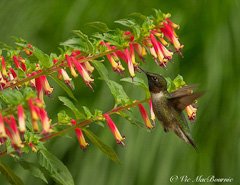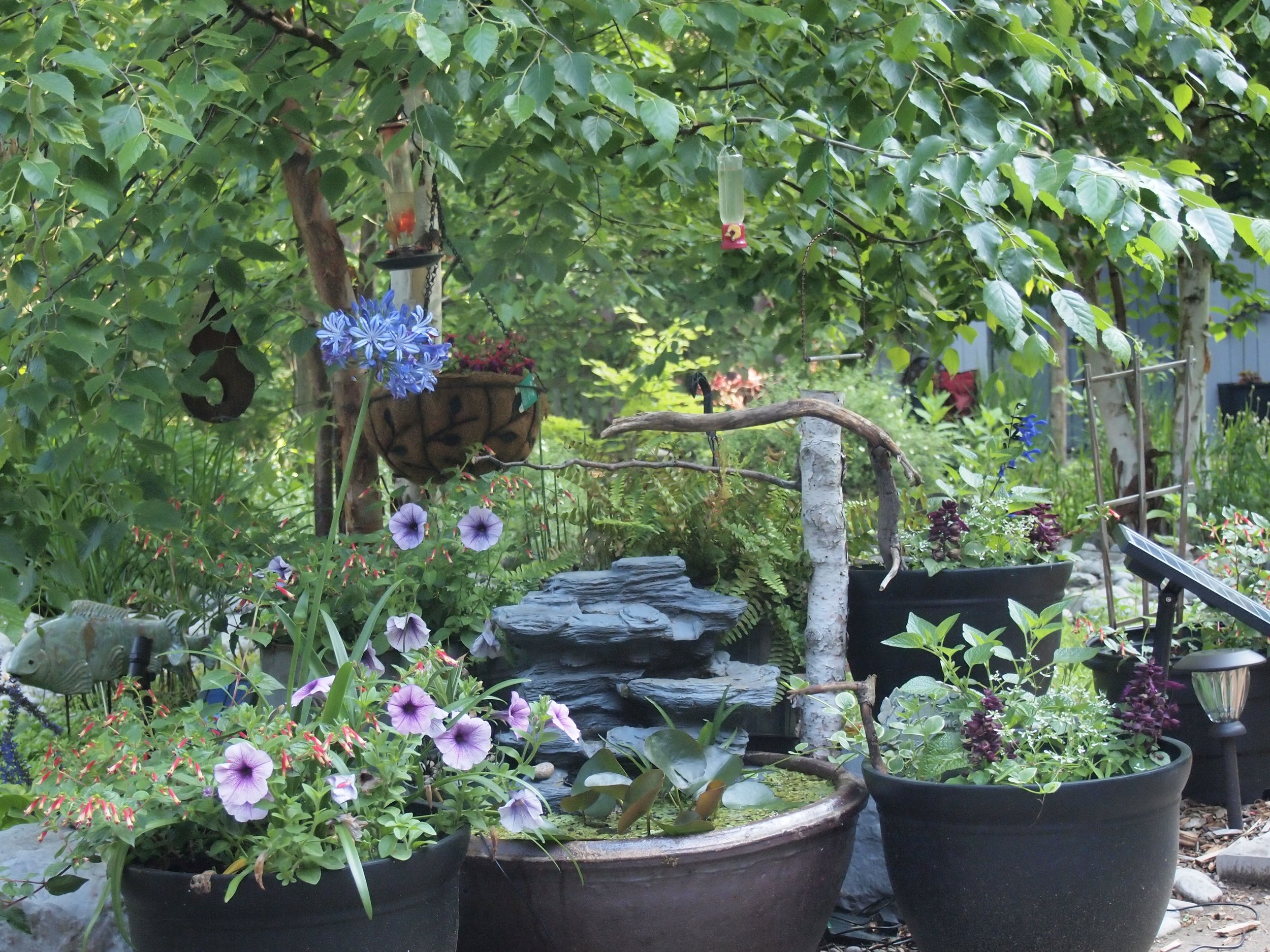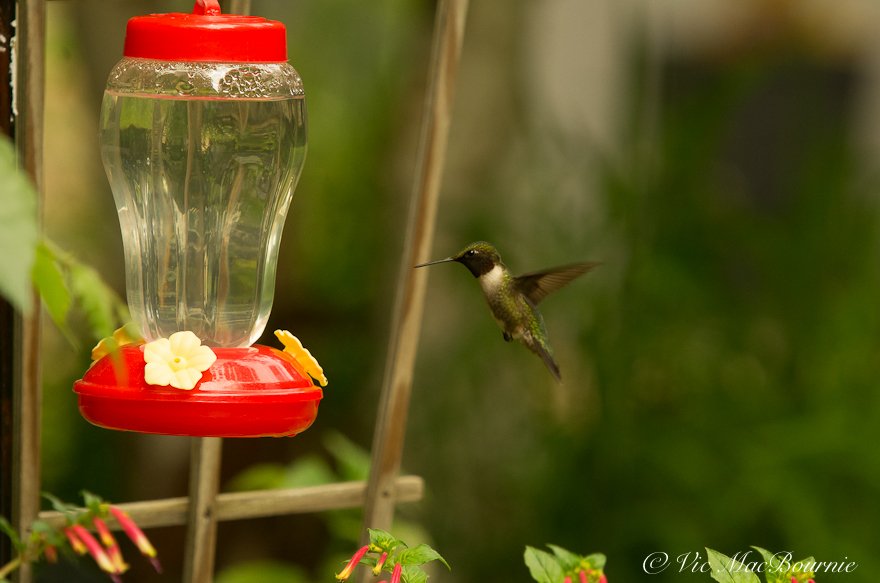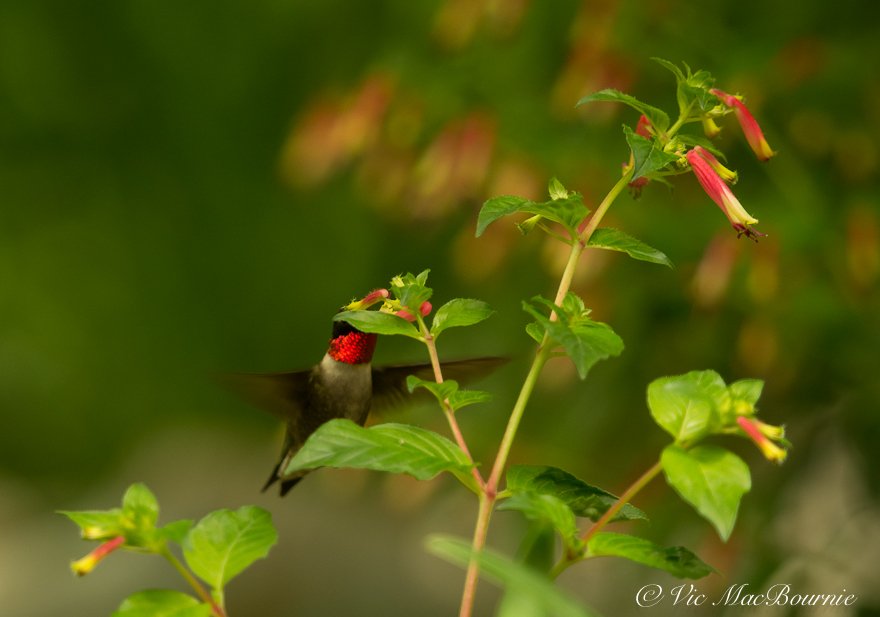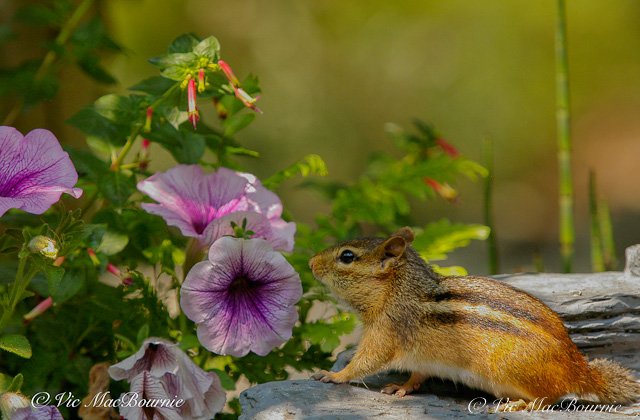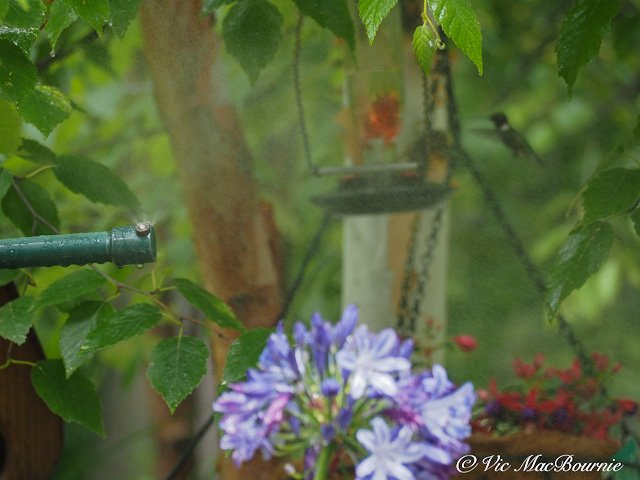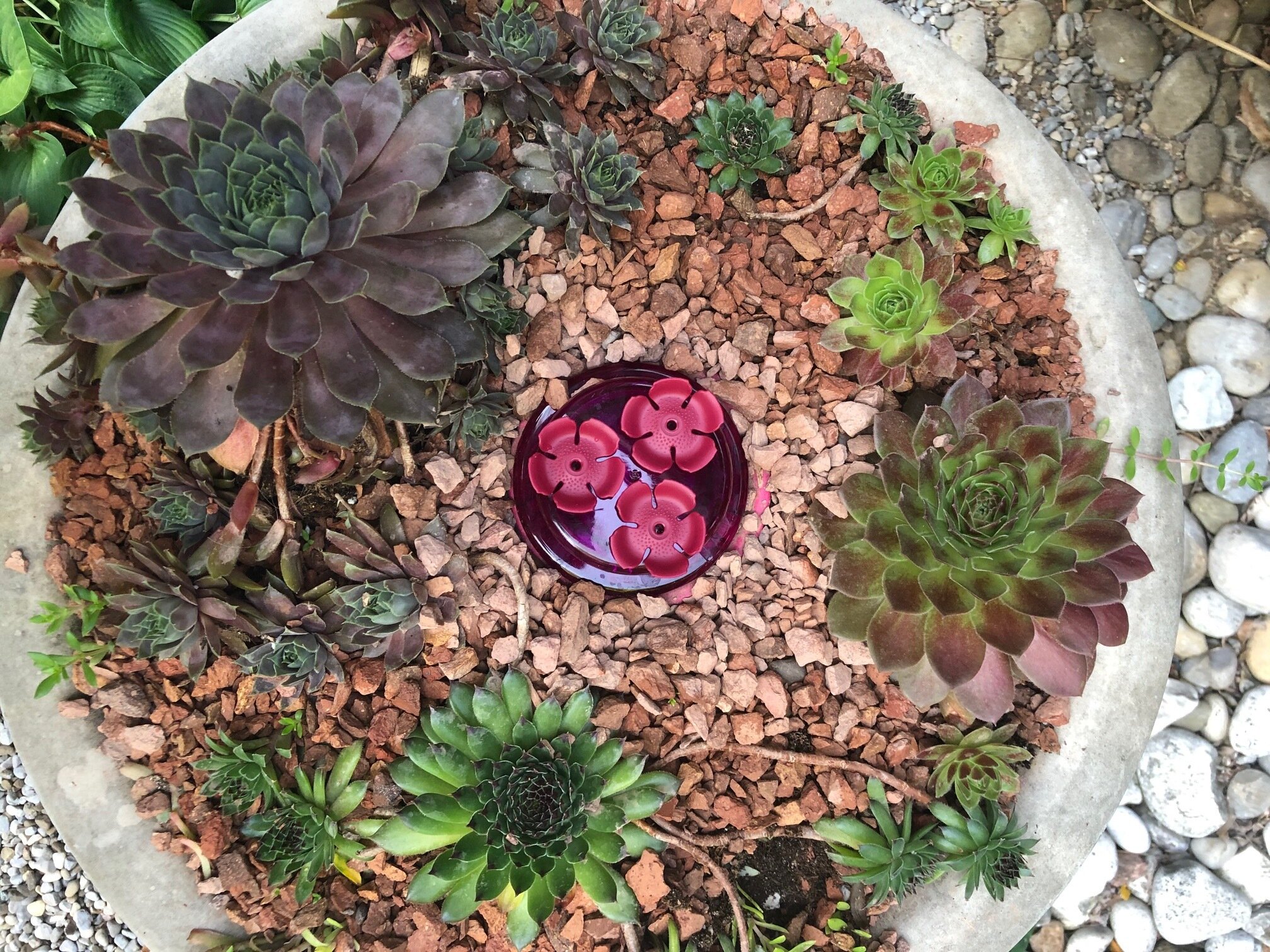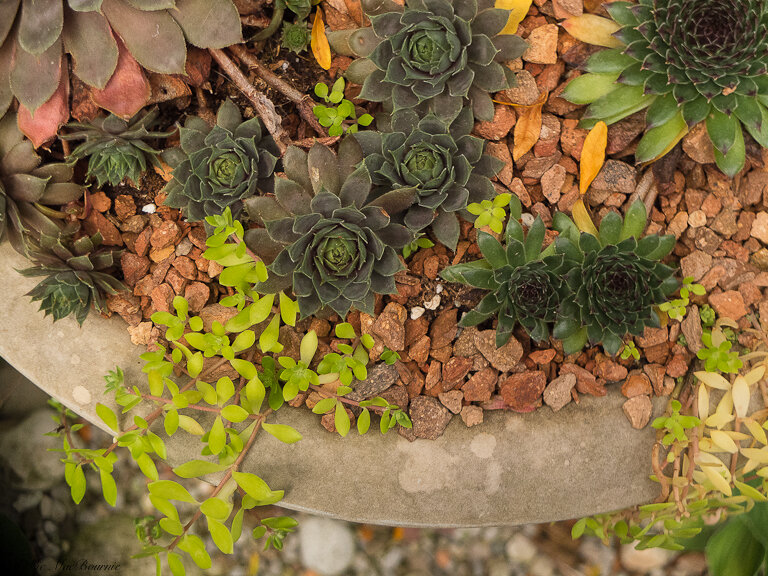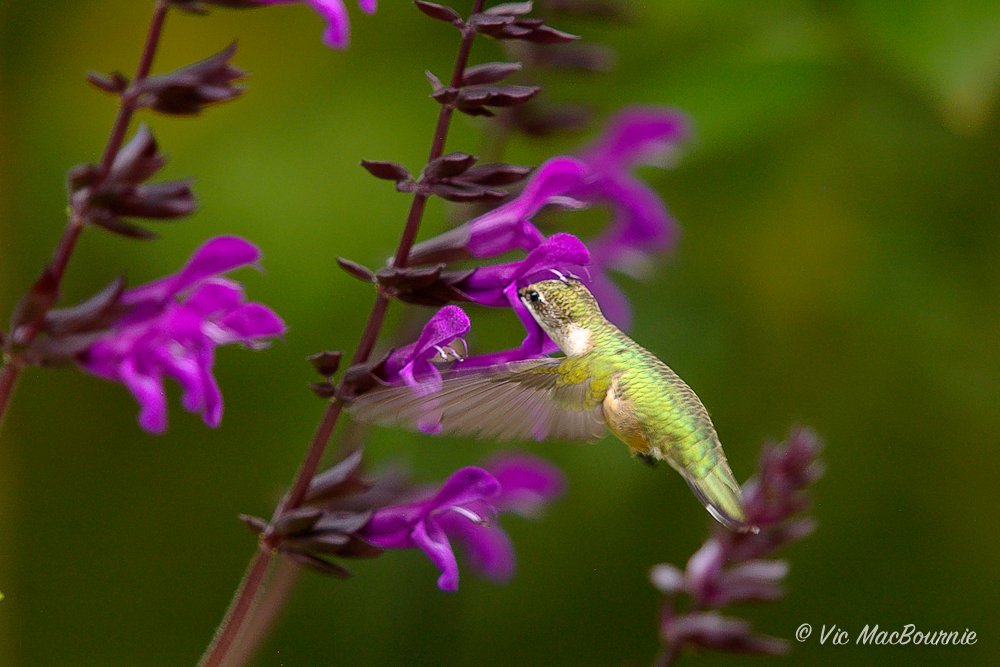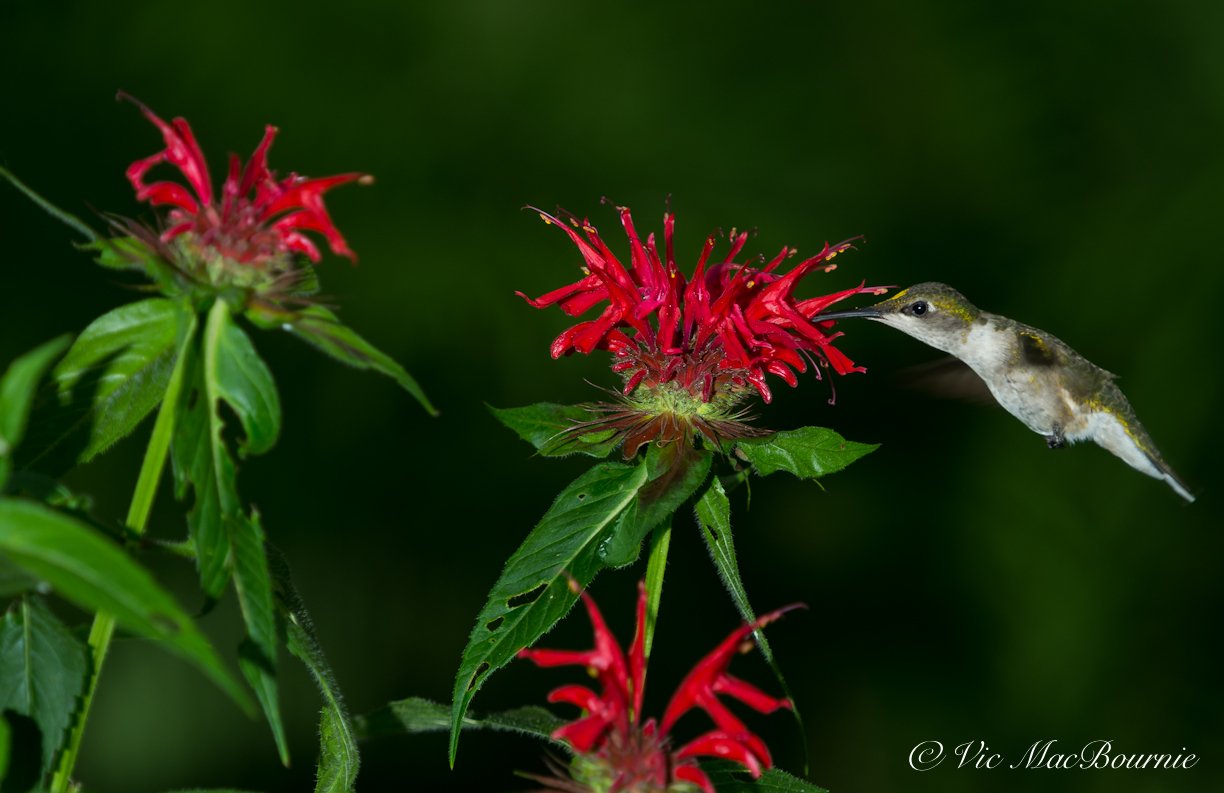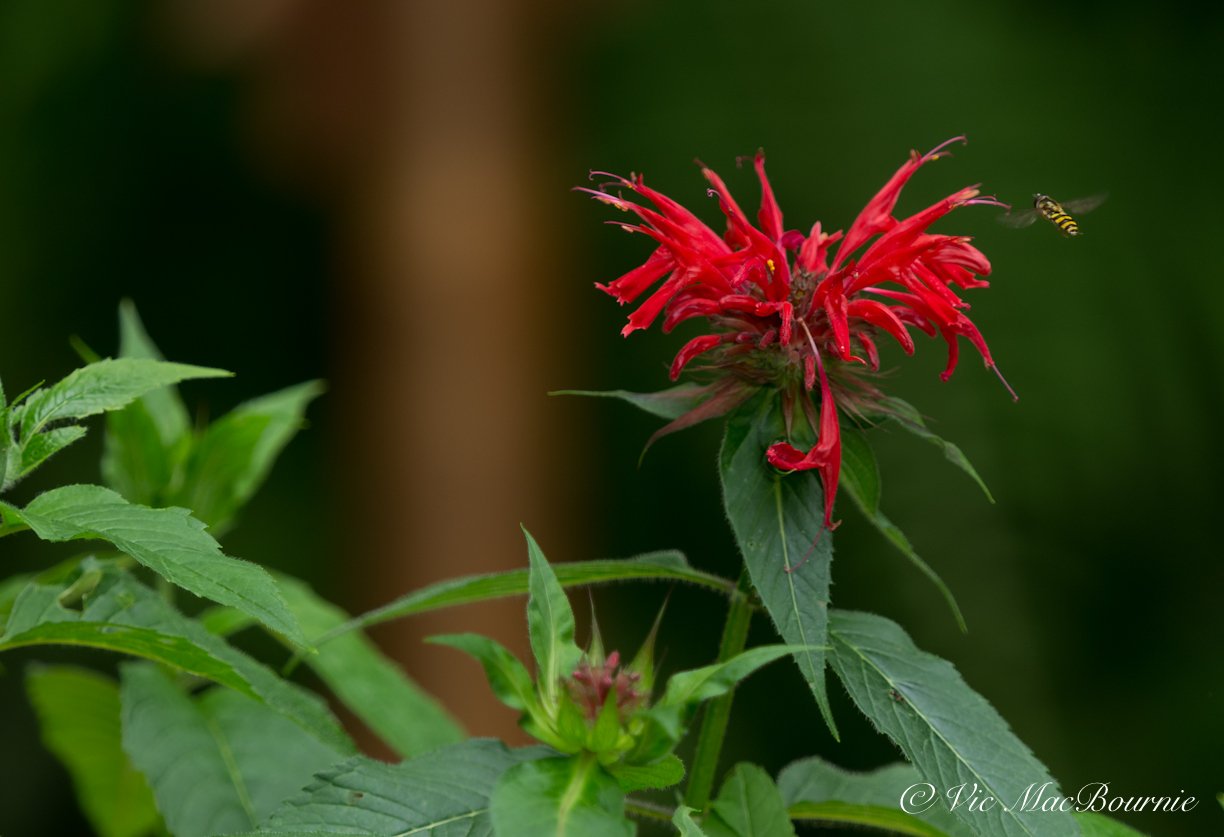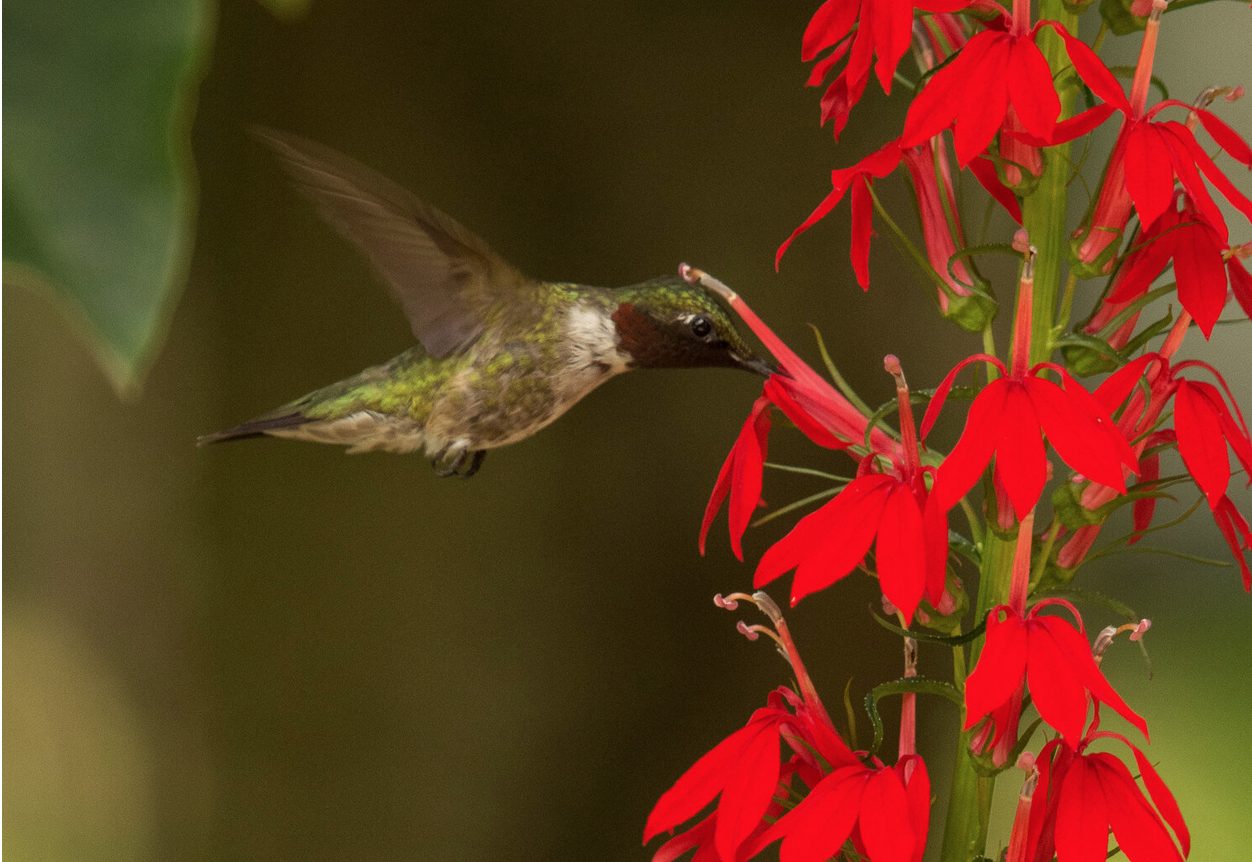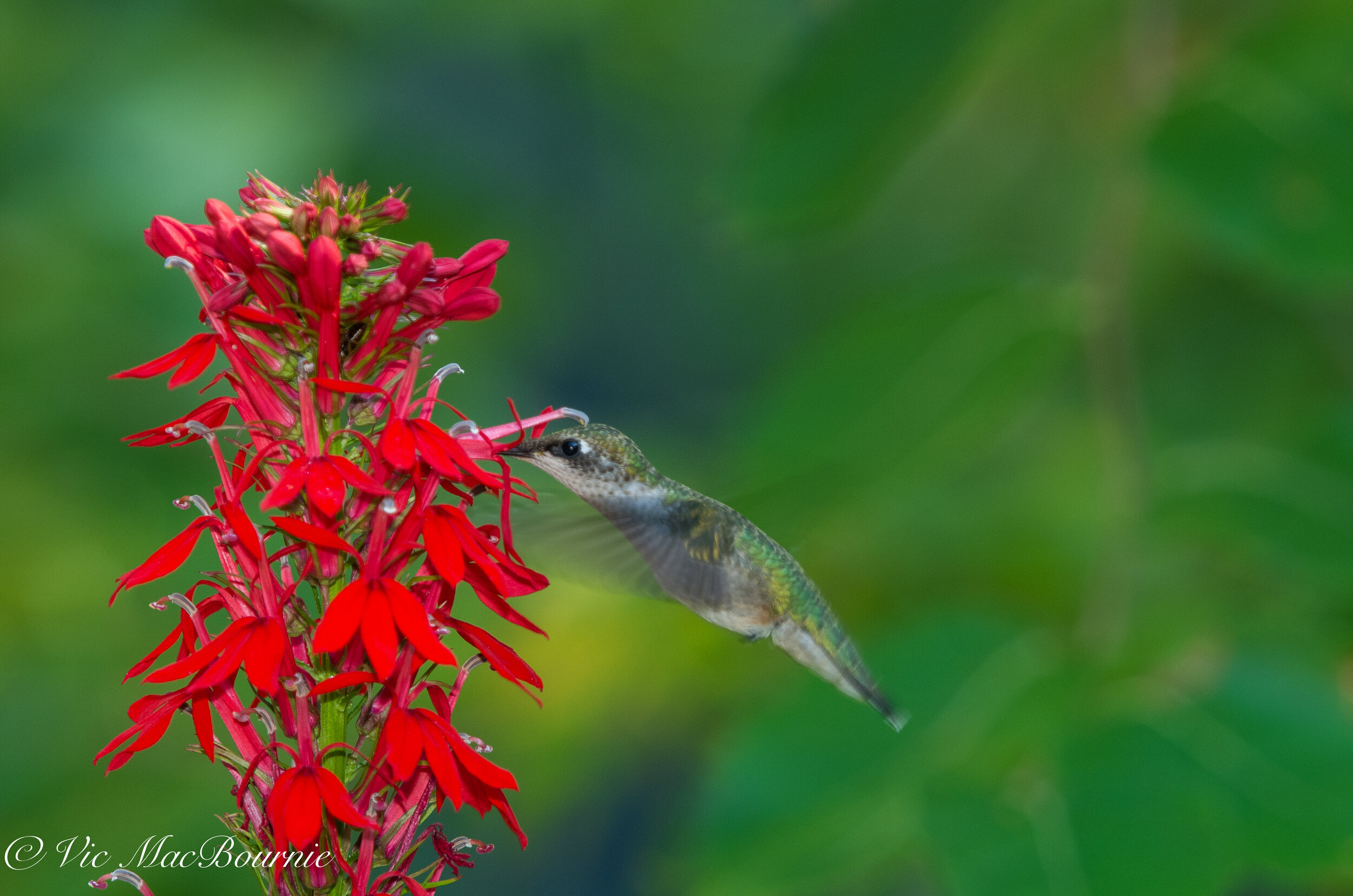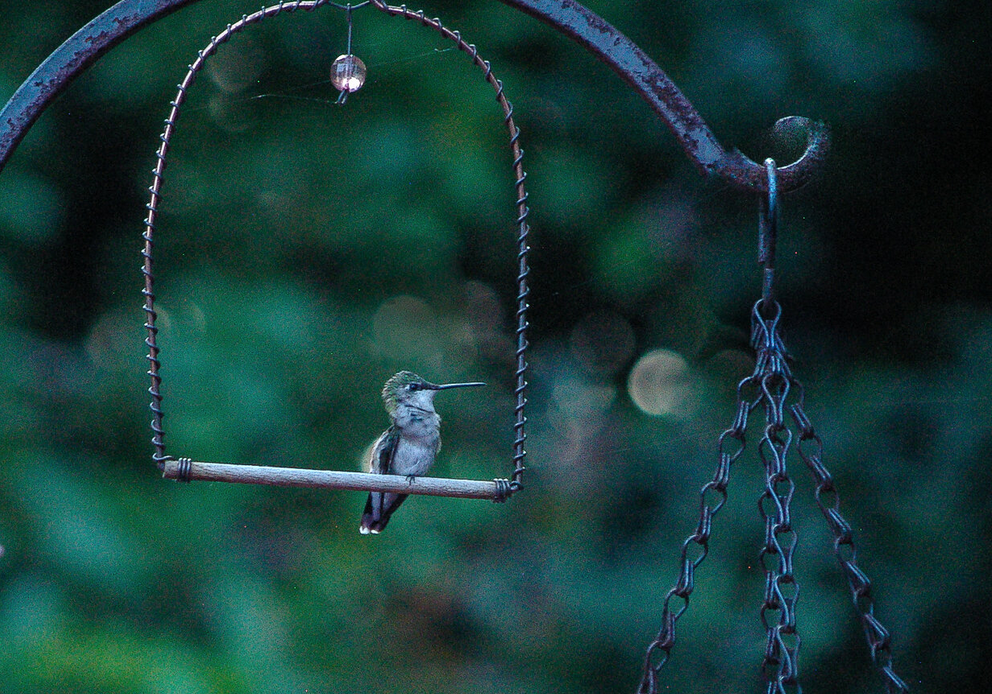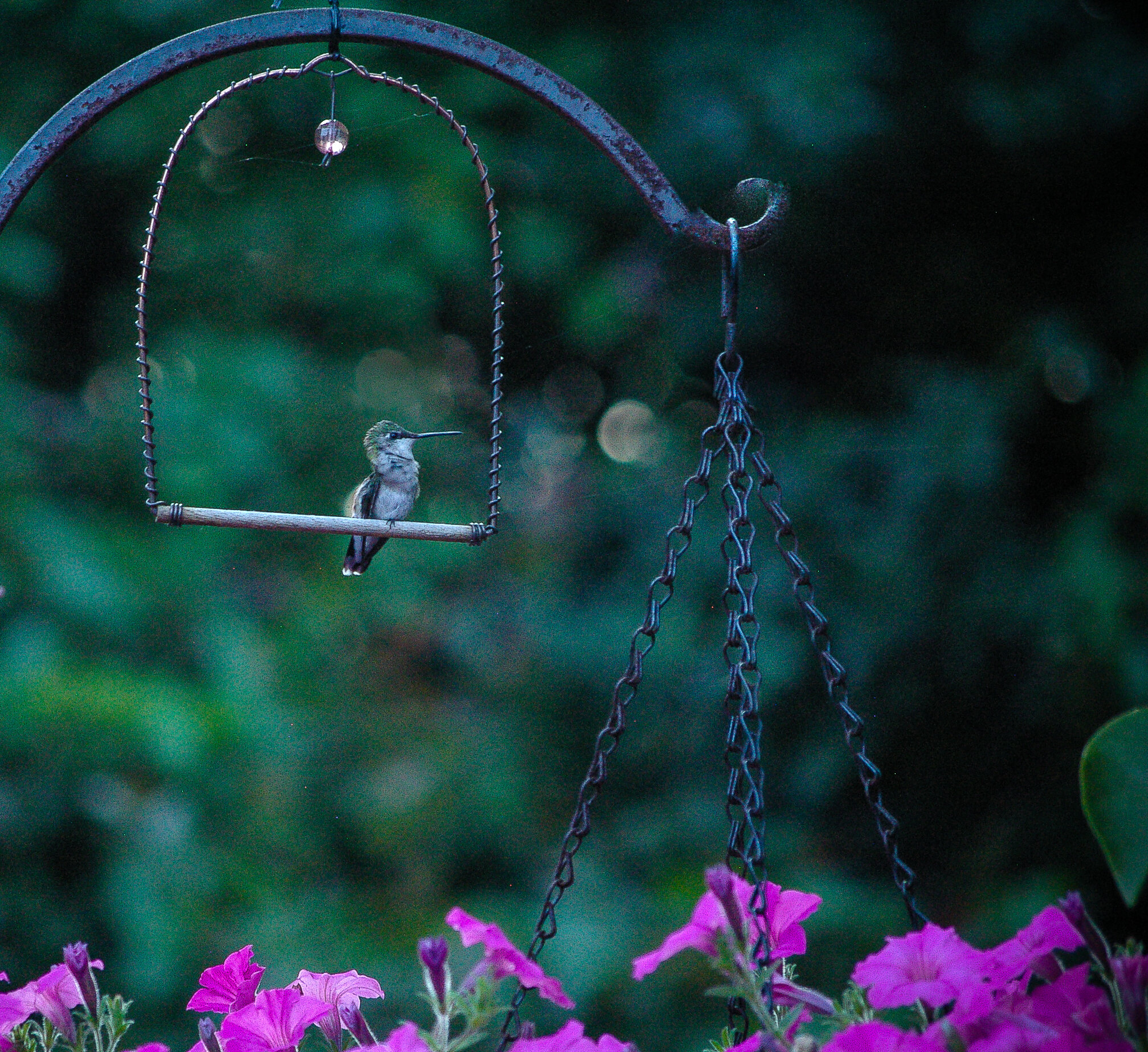Cuphea Vermillionaire takes centre stage in hummingbird corner
If you are looking to attract hummingbirds, you need to include Cuphea Vermillionaire on your list of plants. Grow it in the landscape or in containers and planters.
Firecracker plant adds explosion of colour and hummingbirds love it
Cuphea may be best known for attracting hummingbirds to your garden, but it doesn’t stop there.
Also known as the firecracker plant or cigar plant, Cuphea Vermillionaire is a great plant to add a non-stop riot of explosive colour to your garden, whether it’s grown as a perennial in warmer climates in zones 8 and higher, or an annual in colder zones.
The cigar-shaped red/orange and yellow flowers may not look impressive on their own, but when the plant is covered with hundreds and hundreds of flowers continuously blooming on a single plant, it’s more than impressive.
Different hybrids are available, including one where the flowers are more pink, but if it’s hummingbirds you are after, the regular red and yellow variety is probably the best.
An up-close image of Cuphea showing its dramatic colour and fringed opening.
Cuphea is primary plant in our hummingbird corner
Cuphea is the primary plant making up our hummingbird corner. Three plants in pots surround our patio container pond/waterfalls and form a light airy feel combined with Salvia Black and Blue, petunias and ferns just to name a few.
Three or four commercial feeders are also part of the hummingbird haven that is situated in a corner of our patio where the little birds can be enjoyed to the fullest.
It’s also set up as an outdoor photo studio to make photographing our visitors as easy as possible. Of course, hummingbirds are not the only ones attracted to the area. Butterflies, small birds, dragonflies and our friendly chipmunks are all at home among the almost tropical feel of the corner with the waterfalls, ferns and colourful flowers.
Cuphea might be tricky to find at your nursery
Depending on where you are located, finding the underused annual might be a little tricky.
I went to three of the largest nurseries in our area early this spring asking for the plant and all three not only did not have any, most had no idea what I was talking about.
Funny enough, I stumbled upon the plants at Home Depot where they were selling the plants. I was looking for the Proven Winners variety, because their plants always perform well, but the Home Depot plants are performing admirably in just their first month.
How to grow Cuphea
Cuphea is a real heat loving plant, so be sure to plant it in a sunny area for best flowering and to avoid the plants from getting leggy.
Cuphea Vermillionaire is one flexible, low maintanance flowering plant that does not need deadheading and can handle almost anything you throw at it.
The deep orange tubular flowers dangle on 18-24 inch stems from spring right through to fall and create a mounding form in the garden.
Cuphea growing in container with petunias and other flowers attractive to hummingbirds.
Although Vermillionaire can withstand dry periods better than most plants, it’s a good idea to keep the plant moist throughout the growing season. Once the plant is established, it does not require a lot of water.
If you are growing it as a perennial, it can take up to a year for it to get settled, so be sure to regularly water it in the first year. Also wait until spring growth begins, if you want to do some pruning on it.
Providing regular fertilizer will help keep the plants healthy and constantly flowering.
If you are located in a marginally hardy area, mulch the plant heavily during winter and then remove it in spring.
These plants are certainly worth overwintering if you can.
Unfortunately, Cuphea is susceptible to some garden pests including aphids, whiteflies and Japanese beetles. The hummingbirds will likely feast on the smaller insects, but keep your eye out for any infestations.
Picking off Japanese beetles is probably a good idea and spraying aphids with the hose should keep them under control.
Why do hummingbirds love Cuphea?
The long trumpet shaped tubular plants are particularly attractive to hummingbirds primarily because they are one of the only ones who can feed on these long tubular flowers.
Most bees and butterflies do not have the ability to reach the nectar in the flowers leaving an abundance for hummingbirds.
A male Ruby Throated Hummingbird feeds at Cuphea.
The combination of their long, slender beaks and their even longer tongues make this a plant designed almost exclusively for the hummingbird. That means there is always plenty of nectar available in the plants for the little birds.
The plant’s mounding habit, also makes the flowers very accessible to the birds and their flight pattern enables them to check out several flowers quickly and efficiently.
If you are in a small garden, consider using the plants in containers as a filler plant and pair it with other sun-loving performers. Consider growing them all by themselves in a large hanging basket or paired up with other plants to create a hummingbird hanging basket.
So, be sure to add a few Cuphea plants to your garden this year, whether it’s to attract and feed hummingbirds, or just to add a splash of hot colour to a sunny area of your garden.
Create a hummingbird hangout in your garden
Creating a hangout in your garden just for hummingbirds involves providing them with their favourite things and then sitting back and enjoying the fun they have.
By adding their favourite annual and perennial flowers, a variety of feeders, bugs and water, how can they resist?
Creating a hangout for hummingbirds is not only relatively simple, it will provide hours of entertainment during the summer as more and more of the winged visitors decide your garden is the place to be this summer.
The main ingredients for your hummingbird haven should focus on natural feeders (their favourite nectar-producing annual and perennial flowers) a couple of store bought feeders with a DIY 4:1 water to-sugar-ratio mixture and, if possible, a gentle source of water for a refreshing bath. The gentle source of water can be as simple as a mister or small solar powered fountain in a bird feeder or even a shallow pool of water.
This spring, I decided to focus on creating a central area in the garden that is particularly attractive to hummingbirds. An area that I knew the hummingbirds couldn’t resist but, also, one that would give me the best vantage point to photograph our little friends.
Obviously, hummingbirds were not the only target. I knew that backyard pollinators, like our native bees and butterflies and even other birds, would be regular visitors to the hummingbird hangout, but the focus is definitely on the hummingbirds that have appeared in the backyard every spring for a number of years.
The hummingbird corner aimed at attracting as many of the birds as possible.
Hummingbird hangout makes for the perfect outdoor photo studio
In the past, commercial feeders, native plants and annuals have been situated around our patio attracting them to the general area where I wanted to photograph them. This year, however, my plan was to focus their activity in a smaller corner of the patio and create a natural setting that would make photography much easier, as well create an environment and backdrop for capturing them in the best light.
What I didn’t realize is that it also would create the ideal backdrop for a host of other garden visitors, from bees to butterflies, birds and, of course, our friendly chipmunks.
For more on hummingbirds in the garden, check out the following posts:
• How to help Hummingbirds during migration
• Five tips to attract hummingbirds
Creating the hummingbird hangout
My idea for the hummingbird hangout was simple: Provide the hummingbirds with as many of the flowers they love as natural feeding stations, add a couple of different commercial feeders and place both the feeders and containers filled with their favourite flowers around our container pond equipped with a small waterfalls that I’m hoping will bring even more hummingbirds into the area.
I’m hoping the combination of high-quality, natural feeding stations of their favourite flowers, a reliable source of nectar from the traditional hummingbird feeders and the added sound of gentle running water, will be too much for them to ignore.
The pond and flowers will also attract a myriad of smaller insects and spiders which, we cannot forget, is the number one food source for hummingbirds, especially when they are raising young.
The entire hummingbird hangout is backed by a birch tree clump that is particularly attractive to insects – hummingbirds favourite food source.
Adding a waterfalls to the hangout
I was lucky to have an unused, natural-looking waterfalls that fit perfectly into the container pond and enabled me to create an instant multi-tiered waterfalls. Earlier in the spring, I had seen a Youtube video that showed hummingbirds attracted to a small waterfalls, so, I thought, why not add it to their hangout?
By using a small, inexpensive solar panel and water pump, I hoped to create enough flow to add a nice sound to the entire design. I quickly learned, however, that the inexpensive solar pumps from Amazon and other on-line locations were not going to cut it in this instance.
Not only did these small inexpensive solar-powered pumps struggle to move enough water, the slightest cloud would shut the system down, reducing the joy of having the waterfalls running on a consistent basis.
A hummingbird feeds from what turns out to be the favourite hummingbird feeder.
Getting the best solar-powered water pump for the job
Instead, I opted for a more expensive (but still relatively cheap) larger solar panel and pump that included a built-in battery that the solar panel is able to charge over the course of the day.
The performance of this new, larger solar panel and small pump made by NFESOLAR has been nothing short of outstanding. Not only does it push the perfect amount of water over the falls, it does so even if the sun is behind a cloud. That’s when the battery kicks in and provides that additional power needed to keep the waterfalls working throughout the day.
Most small solar panels shut down immediately if they are not in full sun. Even cloudy days will often stop them from working properly.
If working in shaded situations wasn’t enough to sell me on this solar panel and pump combination from NFESOLAR, the fact that it runs late into the evening on its battery power makes this combination perfect for the hummingbird hangout.
Depending on how sunny it was during the day, the pump will continue to work up to about three hours after the sun is no longer shining on the solar panel.
It certainly helps to have the pump run non-stop all day and into the early evening. Having a continuous flow of water provides birds who visit the waterfalls with the assurance that it will be running during the day. Although I have only seen a single chickadee on the waterfalls in the first weeks of its operation, I’m sure more birds will test the waters once they discover it.
By adding a small amount of seeds on the waterfalls, I’ve encouraged our chipmunks to check it out on a daily basis.
On very hot days, I have a mister that attaches to a hose that can be added to the hangout to make it even more desirable for the hummingbirds and other backyard wildlife.
What plants to use to entice the hummingbirds?
There are a host of plants that can be used to attract hummingbirds, but I opted for a combination of annuals and perennials.
The plants include three Cuphea annual plants (also go by the names firecracker plant or Vermillion), Salvia black and blue annual, columbines, petunias, fuschia and perennial salvia. Very nearby are several cardinal flowers as well as two stands of bee balm.
I have also used plants to create a more natural feel around the pond, including maidenhair and Boston ferns, scouring rush (used in a separate container as well as inside the pond), a hardy dwarf water lilly and pond, a pond bluebell and oxygenators to keep the water fresh.
For a complete list of some of the best hummingbird plants to use in containers or even hanging baskets, check out my earlier post here.
Best hummingbird feeders
When you are choosing the feeders for your hummingbird hangout, consider offering at least a couple of alternatives. I have two feeders hanging from a birch tree directly over the pond and container plants. Another large glass feeder hangs nearby.
One of the two feeders hanging in the birch tree is a large glass feeder, the other is a small tubular feeder that is meant to be hung in a container or hanging basket. Because it is so light, I can hang it out on a small branch for easy access by the hummingbirds. Without any doubt, this is their favourite. In fact, it is so popular I am having to fill up the feeder on a daily basis.
The larger, glass feeder is a great backup in case the smaller tubular feeder is emptied before I can refill it.
I’ve had this larger glass feeder for years and it has performed well, and is easy to clean.
Neither the larger glass feeder or the smaller tubular feeder have perches for the birds to sit on while they feed, but the large feeder nearby has four perches for the birds to feed while resting. The hummingbirds seem to like the perches at times, especially if they are feeding for a prolonged period.
Although the feeders in the hangout don’t have feeding perches for the hummingbirds, I have included a small branch for the birds to land on just above the waterfalls, as well as a larger branch for other birds to stop by a check out the neighbourhood.
However, the birds tend to just hang out in the many small branches provided by the birch tree.
In fact, the hummingbird hangout sits on our patio on the edge of what I like to call our birch grove. The area is made up of three large clump birches overhanging a dry-river bed with a bubbling rock at one end. The shady area is a favourite spot for birds looking for insects and a quick visit to the bubbling rock.
Birch trees attract a lot of insects and caterpillars to the garden and therefore are important trees for hummingbirds and other birds during nesting season when they need an abundance of protein to feed their growing offspring.
DIY: Turn a birdbath into a succulent planter dish (step by step guide)
This DIY succulent hummingbird feeder is a fun gardening idea that is easy to build and beautiful to look at.
How to make a succulent dish garden (with a twist)
Here is a Do-it-yourself project that is both easy to create and results in a lovely succulent dish garden.
I’ve added a little twist by creating a mini photo studio with the addition of a small hummingbird feeder. All you need to complete the project is an old bird bath, some cactus soil, crushed clay stone and a small hummingbird feeder.
The project can be completed in less than an hour and will surely brighten up your backyard and add a great spot to photograph hummingbirds coming to your garden.
Succulents have certainly become popular recently. Here I have used a series of hens and chicks to make the project more hardy to stand up to our cold winters.
The popularity of succulents, however, is for good reason. Today’s succulents are outstanding. Large, small, colourful, tiny, easy to grow and even easier to maintain.
After all, the plants really don’t need a lot of care. Plant them in gritty, well-draining soil mixed with a little stone or pea gravel. Water them in extreme drought if necessary otherwise, just let them take care of themselves.
So with all this in mind, and with an old leaky bird bath sitting empty in the yard, I figured it was a good time to create one of these popular planters.
We’ve had the planter for several years and, besides replacing some of the succulents last year after a brutally cold winter, it has become a focal point along our pathway. I can’t say that it has attracted many hummingbirds over its time, but I’ll keep experimenting with different hummingbird feeders to find one that keeps them coming back.
This small round hummingbird feeder fits the succulent dish perfectly.
I happened to have the small hummingbird feeder designed to teach the tiny birds to eat out of your hand.
Converting birdbath into succulent planter
The project was simple and involved just a few items that I had around the house, and an electric drill.
1) First, I drilled about five holes through the bottom of the fibreglass bird bath to allow good drainage.
2) Then, add pea gravel in the middle area where the hummingbird feeder sits.
3) Next, surround the pea gravel with store-bought cactus soil and mix it with pea gravel to keep it loose and well draining.
4) Now it’s time to plant the succulents around the edges of the bird bath, mixing large and small.
5) I added some sedum that was already growing in the garden
6) I also had a curved wire that looked perfect as a hummingbird resting stop, so that was placed in the container but far enough from the feeder not to interfere with any hummingbirds that might be feeding while in flight.
7) I filled the little hummingbird feeder and placed it in the middle of the succulent container.
8) Finally, red chipped clay stone was placed over the soil as a mulch and a nice clean backdrop for the succulents. The stones help to keep water from splashing up dirt onto the succulents and gives the whole container a more desert feel.
How to care for a succulent dish (birdbath) garden
Caring for a succulent dish – in this case a birdbath – is simple. Succulents do not need a lot of water. In fact, too much water would be the main reason for their demise.
Think desert landscape and you’ll know how much you’ll need to water your dish. I rarely water our succulent dish. Instead, allowing our summer rains to get the job done with the occasional watering works well.
Providing good drainage is probably the most important step you could do to ensure the survival of the plants.
Ours is planted is an area close to the house that gets mostly morning sun into early afternoon.
For more on gardening on a budget, check out my in-depth article here.
Gardening on a budget links
Ten money-saving tips for the weekend gardener
DIY Bark Butter feeder for Woodpeckers
DIY reflection pond for photography
Click & Grow is ideal for Native Plants from seed
Remove your turf and save money
Hiring students to get your garden in shape
If you are interested in backyard birds, please consider signing up for my backyard birds newsletter. The sign-up page is at the bottom of my homepage. Not only will the newsletter provide in-depth articles on attracting, feeding and photographing backyard birds, I am also working with local artisans to provide discounts on incredible bird-related feeders, houses and other goodies backyard birders will love. In addition there will be regular giveaways , including gardening books and birding items.
This page contains affiliate links. If you purchase a product through one of them, I will receive a commission (at no additional cost to you) I try to only endorse products I have either used, have complete confidence in, or have experience with the manufacturer.
Proven Winners’ Salvia gets our patio containers Rockin’
Proven Winners’ Rockin’ Deep Purple Salvia is the star of our patio container this year. It’s been attracting hummingbirds and Bumble Bees like groupies at a rock concert and it’s low-maintenance habits have really made a fan out of me too.
One of our hummingbirds pay Rockin’ Deep Purple salvia a visit. Notice the dark calyx surrounding the purple flowers that give the plant a cool look even when the flower has faded and fell to the ground.
One season of Deep Purple will make you a fan too
Proven Winners’ Rockin’ Deep Purple Salvia are the rock stars of our patio containers this summer.
All you need to do is spend an afternoon on the outdoor patio and there’s no denying Rockin Deep Purple salvia’s popularity. Like groupies at a rock concert the hummingbirds and bees just keep buzzing around the plants. It’s now September, and these plants have been performing since I planted them in spring.
This image catches the hummingbird’s beautiful green feathers against a dark backdrop.
It’s hard to imagine what they have in mind for an encore this fall.
Last year I planted another Proven Winners’ salvia – Rockin’ The Blues salvia – out in the landscape and missed most of the hummingbird action.
This year, however, I decided to put the plants in large black containers on the patio where I could keep a closer eye on its fans.
Our native Bumble bees are in love with the Deep Purple salvias in the garden. If you are interested, check out my post on the importance of our native bumble bees.
The aerial acrobatics is great fun to watch as the hummingbirds battle over the plants.
Oh man, I was not disappointed. The bees and hummingbirds have been visiting the dark purple flowers almost since the day I planted them in spring.
Besides the attractiveness of these plants to pollinators and hummingbirds, their extremely low-maintenance growth habits have made a real fan out of me too.
These hybrid salvias from Proven Winners are not new. They’ve been around since about 2017, but they’re new to me. And they are new to the hummingbirds in our garden who have put these tough, upright plants on their regular hourly feeding rounds for the summer
In fact, as the end of summer approaches, the hummingbirds are actually beginning their aerial acrobatics over and around these Rockin’ salvias in a show of dominance to keep competitors away.
A female hummingbird works the Rockin’ Deep Purple salvia.
When the dark purple flowers are finished blooming, the calyx, which holds the flower petals, remains a really dark purple almost black and gives the effect that the plant is still in bloom, when it’s actually not. Traditional salvias’ calyx’s turn brown and lessen the appearance of the plants. Not these Rockin’ ones.
The light green foliage on the plants looks good throughout the summer too and there is no need for pruning these neatly-growing upright plants or even deadheading.
A dragonfly takes a quick break on the Deep Purple salvia calyx topping off the plant in fine form.
The only chore is to clean up the fallen petals left lying on the ground. I like to leave the purple flower petals on the patio for a while because they look so good just laying there.
Rockin’ Deep Purple salvia is joined by a lighter blue version named Rockin’ Playing the Blues. The entire Rockin’ series features fragrant foliage, a long blooming time, a tolerance for extreme heat and, most important, are very attractive to pollinators.
The Salvias have been alive with Bumble bees from spring through summer.
In addition there is the Rockin’ Golden Delicious with striking yellow-green foliage and Rockin’ Fuchsia with its unique fuchsia coloured flowers.
This hummer eyes its next flower as it makes its rounds in the garden. I love that the flower is in focus here but the hummingbird is just out of the camera’s focus range as it prepares to move in for a meal.
What to expect in the garden
You can expect a height of between 24 - 36 inches on these upright plants in the garden with a comparable spread.
Keep them well watered and fertilize about once a week for best blooms.
Ours are in sun for most of the day and are doing well. Proven Winners says the plants perform at their best in part sun to sun.
The good news is that the plants will bloom from spring right to the first hard frost.
They are hardy in zones 9a, 9b, 10a, 10b, 11a, 11b. In colder zones, you can just treat them like an annual.
Plant them in the garden beds and use them as thrillers in large containers. I guarantee, you won’t be disappointed.
For those who worry about using a cultivar in their garden, Proven Winners say the plant is “sterile so it will not set seed and that means it will just bloom, and bloom and bloom all season without stopping.”
The company also says the salvias “can easily trim to keep the shape or size where you want it, and it will branch out and become even thicker and more full of flowers.
Proven Winners states that: “Regular watering and fertilizing will keep the plant at maximum colour and growth but it is amazingly tough and once established in a pot it will tolerate lower levels of food and water. However, severe drought will cause lower leaves to drop and if this happens give it a quick haircut removing the upper 1/3 of growth and once it’s back to normal watering it will fill back in.”
I could not resist putting in this B&W photo of the lone salvia flower on the leaf. For more garden B&W photography, you can check out my earlier post A woodland garden: Study in B&W.
Just keep on rockin’
Salvias are a great addition to any wildlife garden and a plant that you’ll want to feature in several areas of your garden. Look for spots that you know will get plenty of sun and plug them into the landscape in groupings of three to maximize their benefits.
I like the drama of Rockin’ Deep Purple, but Rocking Playing the Blues added a nice soft blue to the garden last year. Next year I’ll look for Rockin’ Fuschia to add a pop of colour to a sunny spot. I’m thinking they would be showstoppers in our black containers.
Monarda and Cardinal flowers: Native reds Hummingbirds can’t resist
Monarda and Cardinal flower are two native reds Hummingbirds can’t resist. Both have similar tube-like flowers that are perfect for hummingbirds and other pollinators.
A female Ruby-throated Hummingbird works the bright red Bee Balm.
Add these two fine reds to your garden and enjoy the pollinator party
Hummingbirds love reds and the combination of Monarda and Cardinal flowers prove just too irrisistable for them.
You could almost say these native red flowers combine the natural sweet flavours that keep our hummingbirds, bees and butterflies drunk with excitement over the natural abundance of their favourite food. But, that might be pushing the whole red wine thing a little too far.
In our garden, the Monarda begins to bloom in early July and the hummingbirds quickly add them to their daily feeding rounds. I notice, however, that the Cardinal flowers – growing just a few feet away – are not far behind the Monarda. Within weeks the area beside our patio will be a haven for hummingbirds looking to fill up on the sweet natural nectar that these two native reds provide.
If you are looking for more information on growing native flowers, you might be interested in going to my comprehensive article: Why we should use native plants in our gardens.
Our feeders, too, are nearby but given the choice, Hummers will prefer to visit the more natural nectar sources. It’s a good idea to keep this in mind when you are trying to attract hummingbirds and other garden pollinators. Provide their natural food and chances are they’ll visit more often and stay longer.
If using native plants to feed birds and pollinators in your garden interests you, you might want to check out this post on feeding birds on a budget.
Create a natural stage for Garden photography
In addition, the more natural stage for the hummingbirds and butterflies will turn you into a master when in comes to garden photography. There’s nothing like the male Ruby-throated Hummingbird, with its red throat, working the bright red Monarda and scarlet Cardinal flowers. Set up your camera and telephoto lens nearby, grab a glass of your own favourite “red” and just wait for the hummingbirds to arrive. It shouldn’t take long before you are rewarded with some great photographs.
How to grow Bee Balm (Monarda)
Monarda (Monarda didyma) often referred to as Bee Balm is a member of the mint family (Lamiaceae). It joins Wild Bergamot (Monarda fistulosa), that features light lavender to pinkish-white flowers, in the Lamiaceae family that counts 16 species native to North America.
(Go here for my full story on Wild Bergamot )
Monarda can really put on a show. Blooming for up to 6 weeks through mid summer to early fall on tall (up to 4 feet), sturdy square and hollow stems, these attractive perennials have deep roots with shallow rhizomes that account for its spreading habit. It can form large drifts in your garden creating a magnet for hummingbirds and other pollinators including those cool Clearwing hummingbird moths, native bees including bumblebees and, of course, Ruby-throated Hummingbirds.
Like it’s sister, Wild Bergamot, the Monarda flower is actually a cluster of 20 or more flowers (fistulosa) arranged in a round head. The fistulosa (tubular or pipe shapes) make them ideal for long-tongued insects, bees, moths and butterflies to feed on. The plants’ nectar is so sought after by insects that you may notice holes carved out of the flower stems where “tongue-challenged” insects have bore through to get at the nectar.
The plants easily take to a garden and are at home growing along other garden plants, in a sunny meadow-style planting or as specimens in sun, part-shade. Bee balm actually prefers average soil (too rich and you are liable to have tall, lanky plants that don’t hold up well on their own.) Powdery mildew can be a problem if the plants are grown in a wet, humid area without good airflow.
Keep the plants watered but not wet and you’ll be blessed with a great show all summer.
• If you are considering creating a meadow in your front or backyard, be sure to check out The Making of a Meadow post for a landscape designer’s take on making a meadow in her own front yard.
How to grow Cardinal flowers
Cardinal flowers prefer a more wet environment than Monarda so growing them side-by-side will be difficult. Ours grow several feet apart and through hand watering I am able to keep the Cardinal flowers’ feet in more moist soil. Our Cardinal flowers have found a home on the outside edge of a yellow magnolia so also get get less sun than the Monarda plants.
Take a moment to check out my full feature on growing the native Cardinal flower.
Cardinal flowers are considered short-lived perennial but by spreading the seed in your garden, you can enjoy the flowers for years to come. Try placing the spent flower heads atop the soil in a moist part of the garden and you should be blessed with more and more flowers each year. They grow on long spires that can reach up to 4 feet. The flowers bloom as they make their way up the stalk.
In conclusion: Two reds can make a right
Planning your patio should involve more than where the best seating options are, unless, of course, you’re planning the seating options around the best wildlife viewing spots. By making an effort to plant attractive native plants such as Cardinal flower and Bee balm that attract hummingbirds, butterflies and birds, your patio or deck transforms from just a place to sit and entertain, into a place to be entertained.
As summer heats up, I can’t imagine a better time than being outdoors on the patio or deck with my favourite red and a couple of feathered friends dropping by on regular visits.
Focus on Cardinal flowers to attract hummingbirds
If you plant only one flower, make it a Cardinal flower and enjoy the added benefit of hummingbirds. This native North American wildflower is s much at home in the Woodland garden as it is growing alongside a river.
North American native flower that attracts hummingbirds and butterflies
The Cardinal Flower is as close to a guarantee of attracting hummingbirds to your garden as anything, other than maybe a commercial feeder.
But the cardinal flower (Lobelia cardinalis L.), with its spires of scarlet tubular flowers, is certainly more attractive growing throughout the garden than any commercial feeder could ever hope to be.
Be sure to check out my earlier article on how to photograph hummingbirds in the garden and my comprehensive post on Flower photography in the garden.
Adding to its attractive qualities is the fact it is native throughout parts of North America in both the United States and Canada, blooms for a month or longer later in the summer, is slightly aromatic, and is a nectar source not only for hummingbirds but also swallowtail butterflies and other insects and butterflies. The scarlet-coloured wildflower, with delicate blossoms that open from bottom to top on spikes that can reach between two to four feet in height, is a member of the Bluebell family.
If you are looking for more information on growing native flowers, you might be interested in going to my comprehensive article: Why we should use native plants in our gardens.
Here, a Ruby-throated hummingbird feeds at a Cardinal flower a little later in the season. You can see how the flowers on the very top of the plant after earlier blooms have died off leaving a pod of seeds which should be sprinkled about the ground.
What are good companion plants for Cardinal flower?
It’s as much at home in a woodland or shade garden surrounded by hostas and ferns that also enjoy plenty of moisture, as it is as a specimen plant stealing the show in a small, contemporary garden alongside a man-made stream. Look to pair the Cardinal flower with moisture-loving plants that will live happily alongside Cardinal flower.
Where to plant Cardinal flower to easily capture great hummingbird photos
For garden photographers, the plants’ elegant spires stretching up against a blue sky is reason enough to include them in the garden. But the real reason to plant Cardinal flower en-masse is to catch an image of a hummingbird in its natural environment. It’s hard to imagine a more perfect flower to plant in your garden to show off our beautiful hummingbirds in a more natural setting. Plan to spend time, however, working the hummingbird/flower combination. Getting the right light to stop the frenetic motion of the hummingbird requires patience, luck and good lighting.
“Hoping to bring the plant back into the fold, this time in a lower garden within the stone terrace, I picked a seed stalk and placed it on bare soil in a gap next to the flagstones. The next year a seedling sprouted from the gap, and the following year it flowered and went to seed. hundreds of seedlings emerged in the cracks between the stones in the terrace next year. The year after that, a few of these plants flowered and the following year the terrace was a sea of red cardinal flowers. A pair of hummingbirds hovered over the terrace all summer, and my main task was to remove enough of the lush red flowered growth to create paths and a place for my dining table. ”
I have a nice patch of the flowers growing near my favourite patio chair allowing me to easily photograph the tiny, frenetic birds from the comfort of my favourite chair with a coffee – or even better – a glass of wine.
One of the other benefits of planting Cardinal flowers near a patio is the ease of keeping the soil around the plants moist. Hanging baskets and other container plants around our patio get watered daily, so it’s easy enough to water the Cardinal flowers at the same time.
Don’t mistake the plants for weeds. The plants themselves, which appear in spring as dark green leaves, are tapered at both ends. The flowers appear later in summer – July and August – depending on your location.
A cardinal flower in full bloom with the flowers running up the large 2 to 4ft spikes.
Do deer eat Cardinal flowers?
For those of us who are lucky enough to share our backyard with deer, Cardinal flowers have proven to be extremely deer resistant. This might be because all the parts of the plant are considered toxic if eaten in large quantities.
Where do Cardinal flowers grow?
In nature, you’ll find them growing on the edge of woodlands, the banks of streams, near lakes or ponds and swamps. Yes, you can often find them growing happily in moist, wet areas, but you’ll also find them along ditches, along roadsides, in ravines prairies, meadows and even in pastures.
Are Cardinal Flowers native to New England and other areas of the United States?
In the United States they are found growing naturally from Minnesota, south to Florida, Texas and California. They are also native to New England. They are also at home throughout Mexico and through Central and South America.
In Canada, Cardinal flower is native from New Brunswick through parts of Ontario, including down through southern Ontario and throughout the Carolinian zone. In colder areas, adding a mulch layer of leaves over the winter will provide needed protection.
To grow them successfully the plants’ roots need to be kept moist, even wet, but the plants can grow in sun, part shade right through to deeper shade. They prefer to grow in a humus-rich soil, but can do well in medium loam, clay loam and sandy loam.
Cardinal flowers can be easy to grow
In the right conditions, Cardinal flowers are easy-to-grow perennials and will spread in the garden to create lovely drifts of intense flowers. They can, however, disappear quickly if they are not provided with the right conditions because individual plants are actually short-lived perennials. It’s important to allow the plants to reseed themselves in the garden to keep them prospering for years.
Do not cut down the dead and dying stalks without at first distributing the seeds around where they are growing. The seeds need cold stratification to germinate the following spring. One way to better ensure success is to lay the flower stems with seeds in them on top of soil so the seeds disperse and spread on their own. In the picture below, from the book Garden Revolution (link to my review of the book), seeds from a single plant made their way down the terrace following heavy rains a reseeded.
The image of Cardinal flowers taken from the inspiring book Garden Revolution, shows just how spectacular the plant can be in the landscape. These flowers were all grown from a single plant’s seeds spread about the terrace from rains.
In conclusion
It may take a little effort finding native Cardinal flower, but the effort is certainly worthwhile. Not only are they impressive in the landscape all on their own, but the fact they bring our landscapes to life with hummingbirds, butterflies and other pollinators makes them indespensible in our woodland gardens.
In the book Garden Revolution, How our landscapes can be a source of environmental change, (Ferns and Feather book review link) authors Larry Weaner and Thomas Christopher tell the story about how Cardinal flowers played a major role in shaping how they changed their approach to landscaping. Weaner describes his special relationship with the plant in his garden: “A number of years passed and I saw no Cardinal flowers in my yard until one spindly plant emerged from between a grouping of stones. Hoping to bring the plant back into the fold, this time in a lower garden within the stone terrace, I picked a seed stalk and placed it on bare soil in a gap next to the flagstones. The next year a seedling sprouted from the gap, and the following year it flowered and went to seed. hundreds of seedlings emerged in the cracks between the stones in the terrace next year. The year after that, a few of these plants flowered and the following year the terrace was a sea of red cardinal flowers. A pair of hummingbirds hovered over the terrace all summer, and my main task was to remove enough of the lush red flowered growth to create paths and a place for my dining table.”
The image included in the book (above) of a sea of red spikes surrounding the terrace should convince everyone who is not growing Cardinal flower to track them down and get them into the ground as soon as possible.
Garden photography: Tips to photographing hummingbirds in flight
Backyard bird photography involves planning, patience and the right equipment. Months of planning, hours of waiting and about five seconds of shooting resulted in this photograph of the hummingbird at a native cardinal flower.
Planning, patience: Key to capturing garden bird photographs
Garden photography isn’t always easy. In fact, I figure the photo took about six hours of patience and five seconds of shooting.
The result, pretty close to what I hoped for photographing with natural light in the shade of a magnolia tree. An electronic flash would certainly have punched it up both in colour and sharpness, but I decided to go with natural light.
The flash photo can wait for now.
Was luck involved? There is always a certain amount of luck in any good image, but to me luck would have meant getting the photograph in the first half hour, not the sixth.
Photographers looking to do more backyard bird photography might find it helpful to delve a little deeper into the creation of this image.
If I could have only one lens for wildlife and birds in the garden, it would be my F* 300mm F4.5. Check out my full story on the lens by clicking the link.
Much like most bird photography, good planning, lots of patience, and the right equipment went a long way in capturing the image.
Hummingbird feeds from a cardinal flower in the garden.
Planning: The planning started when I ordered the native plant from Onplants.ca back in the spring. I knew hummingbirds loved Cardinal flowers so I ordered three and planted them in an area where they would prosper. Then, I planted it where I would have easy access to them for photography. Beside the patio and a couple of feet from where I normally sit is the ideal location. And, so, that’s where the plants found a home. Nearby, there are three hummingbird feeders that encourage the birds to the general vicinity to where the plant is located.
Patience: Six hours speaks to the patience it took to get the shot. That length of time can be extremely long if you are out in the field, but sitting in a comfortable chair in the backyard makes the wait much easier. It’s one of the big benefits of practising backyard bird photography. Have a coffee, a beer or maybe a glass of wine and take your best shots. Couldn’t be easier.
In most cases a photography blind is not needed when shooting hummingbirds providing you take the time to acclimatize the birds to your presence.
(If you are interested in exploring garden photography at a higher level, be sure to check out my comprehensive post on the Best camera and lens for Garden Photography.)
Looking to upgrade your camera or lenses? Check out the excellent used cameras and lenses at KEH Camera Exchange.
Even if you’re not taking pictures, sitting out in the same chair and moving slowly will eventually cause the birds to recognize you as nonthreatening and allow them to go about their day as if you are not really even there.
This will not work with all birds, but many, especially Hummingbirds will eventually simply ignore you if you are always around their feeders.
Equipment: Bird photography has always been a specialty field involving high-powered cameras, motordrives and long, fast, expensive lenses. A visit to Point Pelee during spring migration, or any other of the birding hot spots around the globe, will certainly convince you that admission into serious bird photography requires more than an iphone or a point-and-shoot camera.
That’s not to say that with very careful planning you can’t get some good shots with these cameras. It’s just that it would be hard to do it consistently and the effort put forward might not be worth the results.
The small size of the hummingbird makes it even more difficult to get good results with these cameras.
So, with that in mind, I took the hummingbird challenge armed with a 35mm SLR camera with built-in motordrive and a 300mm F4.5 close-focusing telephoto lens (with a focal lens of around 450mm on the cropped sensor).
If I could have only one lens for wildlife and birds in the garden, it would be my F* 300mm F4.5. Check out my full story on the lens by clicking the link.
But this was not really the secret behind getting the photograph. They are merely the tools that helped make it possible.
The secret was a tripod, an electronic shutter release, and a camera set on backfocus.
With the camera locked into place on the tripod, and the electronic release ready to trip the shutter without moving the camera, the plan was almost complete.
If you are considering a new camera or lens to capture your best garden photography, travel photography or maybe just your kids and grandchildren, consider checking out the exceptional used camera equipment at KEH Camera Exchange. It’s a U.S. based camera and lens reseller. click on this link to check out their daily offerings.
However, one big problem remained. Normally, when you press the shutter halfway down, the camera refocuses, often going into search mode to find something to focus on. Trying to focus blindly with the hummingbird moving about makes it close to impossible.
That’s where back focus came into play.
What’s back focus you may ask?
On the back of most higher-quality 35mm SLRs is a button that enables the photographer to focus separately from the shutter control button. By using the back focus button, I was able to prefocus on the flowers and then release the shutter without it refocusing when the hummingbird reached the area where I expected it would be in-focus.
Focusing on the flower and then putting the camera into manual focus mode would also have worked.
In the end, the combination of planning, patience and equipment came together to create a pleasing shot. Months in the planning, hours of waiting for the plan to come together and a few seconds of actual shooting made it all happen.
A lucky shot if I ever saw one.
A female ruby-throated hummingbird feeds from a cardinal flower on a sunny afternoon.
Later in the season, I set up a similar situation where the Cardinal flower was primarily in the sun.
The higher shutter speed that the additional light provided helped to get the frenetic little bird in focus and brightened the colours in its feathers. I’m not sure I like the photos any more than the earlier images taken in a shadier part of the garden, but taking it was certainly a simpler process.
Again, patience was the key. The process was similar. Camera on a tripod focused on the flower (again using the back focus button) and a remote release attached to the camera. Every time the hummingbird came to feed, I took several photographs hoping that enough of them would be in focus and sharp.
As I said earlier, photographing the bird in a sunny location brought out the colours, provided a highlight in the bird’s eye and allowed me to shoot at a higher f-stop which helped to capture more of the bird in focus.
This page contains affiliate links. If you purchase a product through one of them, I will receive a commission (at no additional cost to you) I try to only endorse products I have either used, have complete confidence in, or have experience with the manufacturer. Thank you for your support. This blog would not be possible without your continued support.
Five tips to attract hummingbirds to our woodland gardens
Here are five tips to attract hummingbirds to your gardens and keep them coming back for more. Going native and eliminating insecticides in your garden will go a long way to attract these wonderful, entertaining little birds.
Going native and eliminating insecticides are key to success
Just as our hummingbirds prepare to make their arduous journey south to Central America and Mexico for the winter, I thought it was a good time to look at ways we can attract more of these favourite little entertainers back to our yards next year.
For those unable to attract hummingbirds, these tips will go a long way to bring success next year.
Depending on where you live, it can take time to get our local hummingbirds to find our yards and put it on their daily rounds for the entire summer.
Here are five ways we can attract and keep hummingbirds coming back:
Have feeders ready in early spring
1) Have your feeders cleaned and ready to go early in the spring and get them out in the garden before not after you see your first hummingbird. It’s a good idea to track the hummingbird migration on line so you can be prepared for the day they fly through your area. Hummingbirds migrate during the day when nectar sources from flowers are available. Flying low, using tail winds to help them move quickly allows hummingbirds to travel as much as 23 miles in a single day. Tracking the fast-moving band can be challenging and to some degree dependant on local circumstances such as food sources and wind direction.
A native Cardinal flower provides the perfect feeding spot for this female hummingbird.
There are many good websites that will help. Facebook groups can prove to be excellent local sources of information, but there are specific websites that make it their business to track the bands on a more global level. Hummingbirdcentral.com is one that does an excellent job tracking not just the Ruby-throated hummingbird popular in both the U.S., and most of Canada, but also the Black-chinned, Rufous, Broad-tailed, Calliope, Anna’s and Allen’s hummingbirds.
Get your feeders out early in areas of your yard that make them easy for the migrating hummingbirds to see. Rather than filling them completely with your homemade food source at 4 parts of water to one part sugar, maybe fill the feeders halfway until you begin seeing them at your feeders. Then you can fill them fully and keep them filled and cleaned regularly all summer. If you are in a colder climate, try putting a hanging basket of brightly-coloured flowers near the feeders to catch their eye. We have had hummingbirds at our front door checking out fake spring flowers on our wreath long before I realized they were back in town.
Plant both annual and perennial native flowers
2) Ensure you have plenty of annual and perennial flowers in your gardens to provide natural sources of nectar for the hummingbirds and try to have at least some in bloom as early in the spring as possible. Hummingbirds take advantage of everything from flowering shrubs, vines and understory trees to provide them with everything from food, shelter, shade and security. They rely on brightly coloured flowers to find food and are particularly attracted to red tubular flowers like the native Cardinal flower, but any brightly-coloured flower that are tubular will hold nectar. Consider planting native columbines for early spring blooms as well as bee balms, daylilies, lupines foxgloves and hollyhocks. Don’t forget to add lots of annuals that may be available in bloom in early spring if they are greenhouse grown.
Here is a short list of important flowers you should consider for your garden:
Beard tongue (Penstemon), Bee balm (Monarda), Butterfly bush (Buddleia), Catmint (Nepaeta) Clove pink (Dianthus), Columbine (Aquilegia), Corla bells (Heuchera), Daylily (Hemerocallis), Larkspur (Delphinium), Deseert candle (Yucca), Iris (Iris), Flowering tobacco (Nicotiana Alata), Foxglowve (Digitalis), Lily (Lilium), Pentas (Pentas), Petunia (Petunia), Pincushion flower (Scabiosa), Red-hot poker (kniphofia), Scarlet sage (Salvia splenens), Scarlet trumpet honeysuckle Lonicera sempervirens), Summer phlox (Phlox paniculata), Verbena (Verbena), Weigela (Weigela).
Create a shallow, reliable water source
3) Prepare a small water source early in spring to get them accustomed to using it throughout the summer. Although hummingbirds get most of their water from nectar sources both naturally and from our feeders, they do enjoy bathing in either very shallow water or, even better, in a fine mist. A gentle continuous spray from a nozzle or a sprinkler hose will get the job done. There are also commercial misters that are available. In nature, hummingbirds will use water falling from leaves during spring and summer rains to keep their feathers in top condition. A mister or gentle sprinkler spraying on leaves will create a similar situation for the birds. For more, check out my earlier post on providing water for the birds in your garden.
Give hummingbirds a place to rest
4) Provide your Hummingbirds with perches either natural ones in the form of small branches from trees and shrubs or commercially available ones designed specifically for them. Hummingbirds use perches as a base to defend their food sources, hunt insects or just as a resting spot. Males will often use the perches as a spot to vocalize in the spring to attract a mate. These branches are often very thin to accommodate the birds very small feet. If your garden lacks good landing spots, you could use thin wires, like the ones on hanging baskets. For more information on perches, check out my earlier post on hummingbird perches.
Stay away from insecticides
5) Do not use insecticides in your garden. This is probably at least as important as providing the birds with artificial feeders. Nectar provides Hummingbirds with quick energy to sustain their high energy needs, but many people might not realize that Hummingbirds depend on insects to provide them with much-needed protein and various minerals in their diets. They prey on very small flying insects, such as mosquitoes, aphids, mites, gnats, leafhoppers, flying ants and parasitic wasps.
Ultimately though, their favourite food source are spiders, specifically the daddy long legs spiders. Some estimates even have spiders representing between 60 and 80 per cent of their diet. Hummingbirds are known to use their exceptional vision to find prey, and their hovering ability and agility to capture them. Not only to they prey on spiders and other insects that get caught in their webs, Hummingbirds use spider silk that form the web to provide the foundation and glue to make nests in the breeding season.
Hummers catch insects while in flight. If you take the time to really watch your Hummers in the garden, you will notice them dashing into vegetation or flitting back and forth, flying quickly and snatching tiny insects where they swallow them whole.
if your garden is devoid of insects because you or your neighbour regularly spray it with insecticides, don’t expect to be able to maintain a healthy group of hummingbirds. In fact, if you want to encourage hummingbirds, it is important to focus on using as many native plants trees and shrubs as your garden can accommodate. For more on the importance of using natives in the garden, please check out my recent post (here) on the importance of using native plants in our garden.
• This page contains affiliate links. If you purchase a product through one of them, I will receive a commission (at no additional cost to you) I try to only endorse products I have either used, have complete confidence in, or have experience with the manufacturer. Thank you for your support. This blog would not be possible without your continued support.
Are hummingbird swings worth buying?
Adding a hummingbird perch close to a favourite feeder or nectar-rich plant provides the perfect resting place for hummingbirds and an ideal place to photograph the little guys when they are not flitting about.
Perch is ideal for great garden wildlife photography
I don’t know who has more fun the hummingbirds or me, but every morning it’s a swinging good time.
Me with my coffee, Holly resting on her table, and the hummers taking turns on the swing as they make their way to one of the many feeders or native plant groupings in the garden.
Do hummingbirds use store bought swings or perches?
We’ve had the swing for about three years. At first, the hummingbirds didn’t know what to think of it and pretty much left it alone. But it wasn’t long before they took to it and made it one of their favourite landing spots in the garden.
If you are only used to seeing hummingbirds hovering at flowers or a feeder with their little wings buzzing away at more than 50 beats per second, the perch will give you the opportunity to observe them up close preening their feathers and keeping a watchful eye out for competitors.
If you look closely, you might get a good look at their long tongues that they use to lick up the nectar from tubular flowers.
Perches are available at many specialty bird stores and online sources. I purchased ours from Wild Birds Unlimited, but they are also available at Veseys and Walmart as well as Amazon.
The perch is also an excellent spot to set up a camera to photograph them at rest.
Once the hummingbirds start using the perch on a regular basis, you can set a camera up on a tripod and capture some stunning images of the little guys.
Garden wildlife photography can be very rewarding, especially when you can guide the wildlife to where you want to photograph them. You don’t need specialized camera equipment once you get them comfortable landing on the swing in your vicinity.
A good compact camera with a built-in telephoto lens is all you really need. If you are interested in getting more information, check out my post on the Best camera and lens for garden wildlife photography.
Don’t be surprised if they decide the camera is a good landing spot.
For more on hummingbirds in the garden, check out the following posts:
• How to help Hummingbirds during migration
• Five tips to attract hummingbirds
• How long do hummingbirds live
• Where do hummingbirds go in winter
The swing is attached to one of our large, iron plant hooks just above a hanging container filled with Proven Winners Supertunia Vista Bubblegum and just to the right of a hummingbird feeder.
Certainly a lovely spot to go for a swing at any time of day. And if you are looking for an elegant feeder to complement the copper swing, you could do worse than this piece of garden art.
The swings can be purchased commercially or, if you are handy and up for a challenge, can be put together in an afternoon DIY project with some copper wire, beads and either a small branch or a dowel purchased from a hobby store.
Ours is made of a thick copper wire forming the main structure of the swing with a thinner copper band of wire wrapping all around the main wire. The smaller wire helps to hold the small dowel in place for the hummingbirds to sit on and twists up to the top where it holds a lovely red glass bead. I’m not sure if the bead is just for decoration or meant to attract the birds to the swing, but it’s a nice touch.
In case you didn’t know it, hummingbirds are real swingers. Researchers say that hummers spend about 80 per cent of their time perching. So a good perch that swings, is a real find for these little guys.
Now if you know anything about hummingbirds, you know they can be very territorial. Especially when there is a fresh supply of nectar.
The swing is the perfect spot to sit and rest from the enormous task of guarding the food supply, whether that is a batch of homemade nectar (4 parts boiled water to 1 part granulated sugar) or a nectar-rich flowering plant.
Don’t forget to use native flowers in your garden to attract hummingbirds. The plants offer another opportunity to photograph the birds once they begin including the native plants on their feeding routes.
We have located our swing right next to the patio where we can watch the birds on a regular basis. The more they get comfortable with you, the longer they will sit on the swing and pose for photographs.
I can’t imagine going out in the morning and not having the perch for the hummingbirds. Sure they can use a twig from a nearby tree, but providing the perfect spot for them brings them close and allows me to share my coffee time with our little garden friends.
And isn’t that why we have our gardens?
This page contains affiliate links. If you purchase a product through one of them, I will receive a commission (at no additional cost to you) I try to only endorse products I have either used, have complete confidence in, or have experience with the manufacturer. Thank you for your support.

